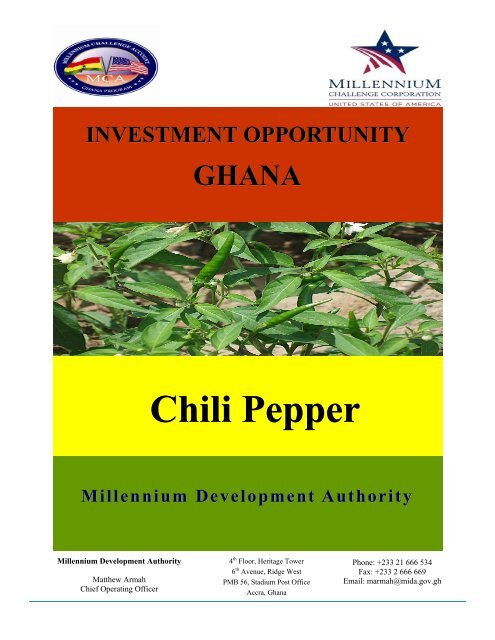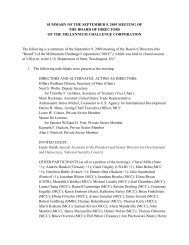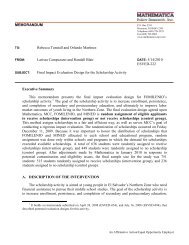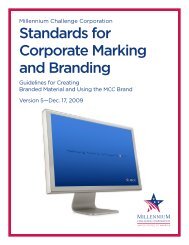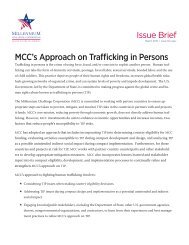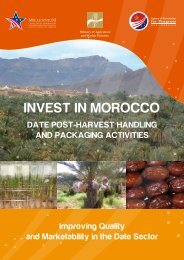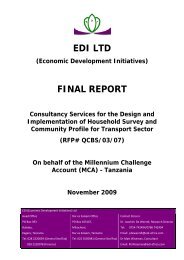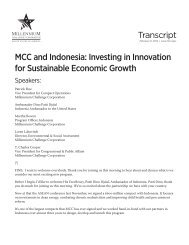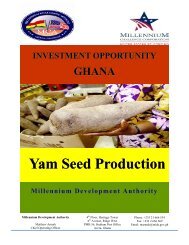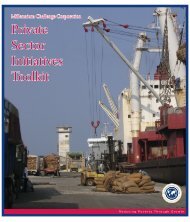Chili Pepper Production - Millennium Challenge Corporation
Chili Pepper Production - Millennium Challenge Corporation
Chili Pepper Production - Millennium Challenge Corporation
Create successful ePaper yourself
Turn your PDF publications into a flip-book with our unique Google optimized e-Paper software.
INVESTMENT OPPORTUNITY<br />
<strong>Millennium</strong> Development Authority<br />
<strong>Millennium</strong> Development Authority<br />
Matthew Armah<br />
Chief Operating Officer<br />
GHANA<br />
<strong>Chili</strong> <strong>Pepper</strong><br />
4 th Floor, Heritage Tower<br />
6 th Avenue, Ridge West<br />
PMB 56, Stadium Post Office<br />
Accra, Ghana<br />
Phone: +233 21 666 534<br />
Fax: +233 2 666 669<br />
Email: marmah@mida.gov.gh
TABLE OF CONTENTS<br />
REASONS TO INVEST IN CHILI PEPPER PRODUCTION IN GHANA…..<br />
BUSINESS OPPORTUNITY SUMMARY……………………………..<br />
CHILI PEPPERS IN GHANA………………………………………...<br />
GLOBAL DEMAND AND SUPPLY OF CHILI PEPPERS……………..<br />
CHILI PEPPER BUSINESS OPPORTUNITY IN GHANA……………...<br />
GHANA’S ENABLING ENVIRONMENT……………………………..<br />
INVESTMENT CLIMATE AND INCENTIVES……………………………<br />
ANNEX I: VALUE CHAIN MAP<br />
ANNEX II: COST STRUCTURE<br />
ANNEX III: LAND ACQUISITION<br />
ANNEX IV: REGIONAL PROFILE<br />
ANNEX V: RESOURCES AND CONTACTS<br />
1<br />
2<br />
3<br />
5<br />
7<br />
9<br />
10
Page 1<br />
REASONS EASONS TO INVEST NVEST IN CHILI HILI PEPPER EPPER<br />
�� Abundant Land with Ample Water Resources<br />
�� Favorable Climate for <strong>Chili</strong> <strong>Pepper</strong> <strong>Production</strong><br />
�� Convenient Access by Air to European Markets<br />
�� Experienced and Well-organized <strong>Chili</strong> <strong>Pepper</strong> Farmers<br />
�� MiDA Support for Agribusiness and Infrastructure<br />
�� Low Labor Costs for Farm Operations<br />
�� Trade and Investment Incentives for Export Businesses<br />
�� Politically Stable Democratic Government<br />
�� Transportation Trade Hub for all of West Africa<br />
�� Warm and Friendly People<br />
PRODUCTION<br />
RODUCTION IN GHANA HANA
BUSINESS OPPORTUNITY SUMMARY<br />
The business opportunity for chili peppers in Ghana is to establish a nucleus farm operation with outgrower<br />
model to export a unique variety, Legon 18, and Bird’s Eye chili peppers to the European markets,<br />
particularly Germany and the United Kingdom. This opportunity allows investors to take advantage of<br />
Ghana’s strengths in chili pepper production.<br />
<strong>Chili</strong> peppers have been widely produced in Ghana for local consumption but have been increasingly<br />
exported to the European market in accordance with the development of Legon 18 in recent years.<br />
Currently, Ghana is the fifth largest exporter of chili peppers to the European Union, where the demand for<br />
chili peppers has been growing annually by 17 percent on average since 2000. Ghanaian chili peppers have<br />
a good reputation in the European markets compared with chili peppers from other countries. Legon 18, in<br />
particular, has a great taste and a longer shelf life. Additionally, Bird’s Eye chili represents a new and<br />
growing opportunity for higher value chili exports.<br />
Ghana’s competitive advantages over other African chili peppers producers are its proximity to the EU for<br />
fresh produce and cheaper airfreight costs. There is also significant available land with plentiful water<br />
resources near the Volta River, Lake Volta, and Ghana’s many other river systems within a few hours drive<br />
from the Kotoka International Airport (KIA). An investor in Ghana’s growing agribusiness sector will be<br />
supported by the <strong>Millennium</strong> Development Authority (MiDA). MiDA is an agency of the government of<br />
Ghana that is focused on increasing the production and productivity of high-value cash crops in specific<br />
intervention zones. MiDA’s programs and activities provide additional services from which investors will<br />
benefit:<br />
�� Up to 60,000 farmers trained in business planning and value chain approaches<br />
�� Infrastructure projects improving key transport corridors<br />
�� Renovation project to provide cold storage capacity at KIA<br />
�� Land tenure facilitation to ensure tenure security for land users and facilitate access to land<br />
�� Credit services to increase farmers’ access to credit for the improvement of value chain activites<br />
The farmers trained under MiDA’s programs are well-organized farmer-based organizations (FBOs) that<br />
can provide excellent outgrower relationships for a chili pepper nucleus farmer. A 250 acre nucleus farm<br />
operation with 100 acres of outgrowers for the export of chili peppers in Ghana is forecasted to yield a firstyear<br />
revenue of GH¢9.8 million ($7.0 million) and net profit of GH¢4.5 million ($3.25 million) as<br />
operations scale up, with estimated revenue increasing to GH¢19.7 million ($14.0 million) and profit of<br />
GH¢9.6 million ($6.8 million) by the third year of operations.<br />
The <strong>Millennium</strong> Development Authority (MiDA) is a Ghanaian public agency, created to implement the<br />
programs pertaining to the <strong>Millennium</strong> <strong>Challenge</strong> Compact valued at $547 million and signed in August<br />
2006 between the Government of Ghana and the Government of the United States. The Compact includes<br />
an allocation of $241 million for Agriculture Projects to increase productivity and $306 million for<br />
Transportation and Rural Services Projects that will complement the strengthening of capacity in the<br />
agricultural sector. MiDA will facilitate investment in this business opportunity for interested domestic<br />
and foreign partners, including access to farmer organizations, community leaders, service providers,<br />
government agencies, and other organizations as necessary. See MiDA’s website at http://<br />
www.mida.gov.gh.<br />
Page 2
CHILI PEPPERS IN GHANA<br />
Page 3<br />
Current <strong>Production</strong><br />
<strong>Chili</strong> peppers have always been part of Ghana’s agriculture and diet. <strong>Chili</strong> peppers require sunny, semitropic<br />
or tropical conditions and annual rainfall of between 600mm and 1,250mm. <strong>Chili</strong> peppers have a<br />
relatively quick growing and harvesting period of 3 to 4 months in Ghana and are generally grown by<br />
local farmers during the rainy season.<br />
Specialty <strong>Chili</strong> <strong>Pepper</strong>s<br />
Most chili peppers are currently produced under rainfed conditions<br />
without irrigation systems, which causes a significant drop in<br />
production volume during the dry season. It is estimated that the<br />
Ghanaian chili farmers are only producing at 50 percent of<br />
attainable yields because of the lack of irrigation systems and<br />
improved inputs. After harvesting, farmers sell their chili peppers to<br />
exporters at farm gate prices ranging from GH¢ 0.5 to 1($0.35-0.70)<br />
per kilogram throughout the year.<br />
Although Ghana has been exporting chili peppers for over fifteen years,<br />
significant growth in the production of chili peppers for export is<br />
relatively recent phenomenon. The growth in exports was prompted by<br />
the development of a hybrid chili pepper, Legon 18, developed<br />
specifically for Ghanaian soil by researchers at the University of Ghana-<br />
Legon. In addition to being well-suited to Ghanaian soil and climate<br />
conditions, Legon 18 is designed to maintain freshness to enhance its<br />
exportability. Since becoming more widely available, Legon 18 has been<br />
increasingly produced for export by local farmers through MiDA<br />
technical training programs and is now exported to nine countries.<br />
Bird’s Eye <strong>Chili</strong> <strong>Pepper</strong><br />
Legon 18 <strong>Chili</strong> in Sogakope<br />
Bird’s Eye chili pepper production has also been increasing in Ghana.<br />
Bird’s Eye pepper is widely produced in India, Thailand, Vietnam and<br />
Malaysia. Bird’s Eye chili has a very high capsicum content, which are<br />
100,000 to 225,000 Scoville Heat Units, and therefore yields a high market<br />
price in export markets and experiences less price volatility. This is partly<br />
due to its alternative industrial use in pepper spray. Bird’s Eye chili grows<br />
in similar conditions to Legon 18; thus Ghanaian climate and soils are<br />
suitable for its production. For these reasons, Bird’s Eye chili pepper<br />
production also represents an opportunity for a nucleus farmer model.<br />
MiDA Sector Intervention: Business and Technical Training for Farmers<br />
MiDA is providing training to approximately 60,000 farmers. Farmers participate in six weeks of<br />
classroom training on business aspects of farming, FBO organizational development, and crop<br />
planting decisions based on market dynamics. Farmers also receive three weeks of field training<br />
on a specific crop, assisted with a starter kit of inputs for the chosen crop. Legon 18 is one of the<br />
value chain crops, which has become increasingly popular among farmers.
<strong>Production</strong> Volume and Export Trends<br />
The production volume of chili peppers remained relatively constant<br />
during last 10 years. It increased slightly from 270,000 metric tons in<br />
2000 to 277,000 in 2006 and 279,000 in 2008 along with increased<br />
availability of the Legon 18 seed variety and MiDA’s chili pepper<br />
production training programs. Currently Ghana is producing about<br />
279,00 metric tons.<br />
metric tons<br />
Ghana <strong>Chili</strong> and <strong>Pepper</strong> Export<br />
5,000<br />
4,000<br />
3,000<br />
2,000<br />
1,000<br />
0<br />
2005 2006 2007 2008<br />
Source: ADRA Ghana<br />
Good Reputation in European Markets<br />
According to an international exporter operating in<br />
Ghana, Legon 18 has built a very good reputation for<br />
taste and quality in European markets. While regular<br />
fresh green chili peppers have a shelf life of only<br />
three days, Ghanaian Legon 18 has a shelf life of<br />
more than one week. It remains crisp and fresh on the<br />
shelf, which is preferred by customers and beneficial<br />
to importers in terms of reducing losses from<br />
spoilage.<br />
<strong>Chili</strong> peppers that are picked at farms are transported<br />
to the airport and loaded to air cargo carriers. The<br />
peppers will be on the shelf of supermarkets in UK<br />
on the next day, fresh.<br />
metric tons<br />
280,000<br />
275,000<br />
270,000<br />
265,000<br />
Ghana <strong>Chili</strong> <strong>Production</strong><br />
Ghanaian chili exports have ranged between 26,000 and 41,000 metric<br />
tons over the past 5 years. Exports increased about 60 percent from<br />
2005 to 2007 since Legon 18 started being exported. However, chili<br />
pepper exports decreased in 2008 due to the global recession.<br />
Ghana exports chili peppers to the European markets, with top export<br />
destinations in Germany, the United Kingdom (UK) and Switzerland,<br />
where exporters can realize benefits from cheap transportation costs<br />
and well-developed cargo networks.<br />
In order to reach European markets, chili peppers are generally<br />
harvested early in the morning and are transported to the Kotoka<br />
International Airport for overnight transportation. <strong>Chili</strong> peppers from<br />
Ghana are on the shelf in Europe the day after harvest.<br />
Top Export Destination (2000‐2008)<br />
Germany United Kingdom Switzerland<br />
15%<br />
77%<br />
Packaging and Processing Opportunity<br />
Currently, chili peppers are exported fresh<br />
from Ghana and generally are not packaged or<br />
processed in any way. In European markets,<br />
specialty packaging and cut or semi-processed<br />
chili peppers are becoming more popular as<br />
the customer base expands. Certain customer<br />
segments are willing to pay more for visually<br />
appealing cut or semi-processed chili peppers,<br />
and Kenyan exporters have begun to enter this<br />
market segment. There is an opportunity for a<br />
nucleus farmer to realize increased profits by<br />
moving upmarket with high quality Ghanaian<br />
chili peppers.<br />
8%<br />
Source: FAOSTAT<br />
Source: UNCOMTRADE<br />
Page 4
GLOBAL DEMAND AND SUPPLY OF CHILI PEPPERS<br />
Global Supply<br />
2,500,000<br />
2,000,000<br />
1,500,000<br />
1,000,000<br />
World chili pepper production has grown on average 3.9 percent per year during the last 10 years led by<br />
a steady increase of global demand. The main chili peppers producers in the world are China, Mexico,<br />
and Turkey, which in total account for more than 70 percent of the world chili pepper production. The<br />
leading global exporters include Mexico, the Netherlands and Spain. Ghana ranks 11 th place among the<br />
global chili producers, producing approximately 1 percent of total global production.<br />
metric tons<br />
Page 5<br />
Global Demand<br />
World demand and supply of chili peppers have been steadily<br />
increasing. Between 2000 and 2007, fresh chili and peppers<br />
increased on average 6.6 percent per year in the world and 6.3<br />
percent per year in Europe. Ghana has mainly focused on the<br />
European market, particularly Germany and the UK, because of<br />
its proximity and resulting comparative advantage over other<br />
African countries in terms of air transportation costs.<br />
30,000,000<br />
25,000,000<br />
20,000,000<br />
15,000,000<br />
10,000,000<br />
5,000,000<br />
0<br />
<strong>Chili</strong> and <strong>Pepper</strong>s <strong>Production</strong><br />
Year<br />
World<br />
Africa<br />
Ghana<br />
Source: FAOSTAT<br />
3% 2%<br />
3%<br />
4%<br />
5%<br />
7%<br />
8%<br />
2%<br />
1%<br />
1%<br />
Although several Western European countries are themselves exporters of chili peppers, there is a<br />
supply and demand gap in those countries during the winter. This is the time when demand and price for<br />
exported chili peppers reach their peak in Europe. Because of its tropical climate throughout the year,<br />
Ghana can supply to Europe during its high demand winter season. However, winter in Europe<br />
corresponds to Ghana’s dry season, so irrigation is necessary to enable Ghanaian chili production to<br />
capitalize on the higher demand and prices during the European winter season.<br />
metric tons<br />
8%<br />
500,000<br />
World <strong>Chili</strong> and <strong>Pepper</strong>s Import<br />
0<br />
World <strong>Chili</strong> Producers<br />
56%<br />
China<br />
Mexico<br />
Turkey<br />
Indonesia<br />
Spain<br />
United States of America<br />
Nigeria<br />
Egypt<br />
Korea, Republic of<br />
Netherlands<br />
Ghana<br />
Others<br />
Source: FAOSTAT<br />
2,058,703<br />
Source: FAOSTAT
European Demand and Supply of <strong>Chili</strong> <strong>Pepper</strong>s<br />
Demand in Targeted European Markets<br />
The primary customer segment for chili peppers in Europe is<br />
the Asian ethnic groups in these countries, and several<br />
Ghanaian exporters have established strong business<br />
relationships with these markets in European cities. However,<br />
opportunities are not limited to these sectors, as more<br />
mainstream supermarkets now carry many varieties and choices<br />
of vegetables and peppers from around the world as consumer<br />
preferences expand.<br />
Supply to European Markets and Competition<br />
Ghana’s main competitors in the chili pepper export sector to European market are Israel, Morocco,<br />
Turkey, and Egypt. These countries have comparative advantages over Ghana due to cheaper air<br />
transportation costs based on their proximities to Europe. Ghana only accounts for about 1 percent of the<br />
EU market share. In Africa, Kenya, Uganda and South Africa are Ghana’s main competitors. Ghana has a<br />
comparative advantage over these African countries in terms of shorter transport times and relatively<br />
inexpensive airfreight costs.<br />
Moreover, Ghanaian chili peppers have been establishing a strong reputation by their great quality and<br />
taste as well as a longer shelf life. Ghanaian exporters seek opportunities to reach out to the mainstream<br />
customer segment through chain supermarkets in addition to the current niche Asian ethnic consumer<br />
markets. With expansion into larger supermarkets, quality will be a critical factor, which brings Ghanaian<br />
chili peppers an advantage over chili peppers from other countries.<br />
1%<br />
2%<br />
19%<br />
27%<br />
8%<br />
<strong>Chili</strong> Exporters to EU<br />
43%<br />
Israel<br />
Morocco<br />
Turkey<br />
Egypt<br />
Ghana<br />
Other partners<br />
Source: UNCOMTRADE<br />
metric tons<br />
Morocco<br />
300,000<br />
250,000<br />
200,000<br />
150,000<br />
100,000<br />
50,000<br />
0<br />
GHANA<br />
<strong>Chili</strong> <strong>Pepper</strong>s Import<br />
Year<br />
Turkey<br />
Israel<br />
Source: UNCOMTRADE<br />
UK<br />
EU‐27<br />
Source: UNCOMTRADE<br />
Page 6
Page 7<br />
CHILI PEPPER BUSINESS OPPORTUNITY IN GHANA<br />
The business opportunity for chili peppers in Ghana is to establish a nucleus farm operation with outgrower<br />
relationships to export Legon 18 and Bird’s Eye <strong>Chili</strong> peppers to European markets.<br />
<strong>Chili</strong> <strong>Pepper</strong> Nursery<br />
Land Prepared for <strong>Chili</strong><br />
production in Kwahu South<br />
This opportunity allows investors to take advantage of Ghana’s strengths in<br />
chili pepper production. Readily available, inexpensive land with ample water<br />
resources located close to Kotoka International Airport (KIA) provide the first<br />
set of key attributes that Ghana has to offer. The well-developed international<br />
and regional transportation network in Ghana, in addition to the experienced<br />
and organized local farmers, are important benefits to the potential chili<br />
investor. <strong>Chili</strong> pepper is also known as a high-value agricultural product,<br />
which tends to require 2 to 4 times more labor than cereal crops. Such labor<br />
intensiveness provides great opportunities for Ghana. The official minimum<br />
wage in Ghana is GH¢ 3.11 per day, although farms typically pay in the range<br />
of GH¢ 3-5 per day $2.22-$3.57) and GH¢ 150 ($107) per month for<br />
agricultural laborers.<br />
Transportation System– Ghana is a transportation hub of West Africa to Europe. KIA is only 6 hours<br />
flight time from most major European destinations. Nucleus farmers can take advantage of the system of<br />
major roadways between nucleus farm operations from as far as 4 hours from the airport. Air freight costs<br />
from Ghana are significantly lower than from other parts of Africa, providing Ghana with a competitive<br />
advantage versus other vegetable and chili exporters, such as Kenya and Uganda. Freight costs to the UK,<br />
for example, are $1.10 per kilogram by Air Ghana compared to Kenyan costs of $1.90 per kilogram.<br />
Currently, Ghanaian farmers and exporters do not use cold chain transportation or storage to preserve the<br />
quality of chili peppers. Yet, they are able to provide fresher chili peppers with a longer shelf life of 1 week<br />
than peppers from other countries, which usually have only a 3 day shelf life.<br />
Land Acquisition– Ghana boasts vast amounts of available, fertile land<br />
close to water resources. However, foreign investors can find the process of<br />
negotiating land leases daunting due to the traditional systems in place in<br />
many agricultural areas. Price and terms will be directly negotiated between<br />
investors and land owners, which may be traditional authorities. MiDA and<br />
its partners provide critical assistance in locating attractive land and<br />
facilitating the process with local authorities. More details on land<br />
acquisition in Ghana are described in Annex IV.<br />
MiDA Sector Intervention: Cold Storage at the Kotoka International Airport<br />
MiDA is rehabilitating the existing cold storage at the Kotoka International Airport for the export of<br />
fresh fruits and vegetables. The planned capacity of the facility is 1,200 square meters, and the<br />
rehabilitation is expected to be completed by the end of 2011. Upon completion, investors will be<br />
able to store fresh vegetables while waiting to be exported by air cargo carriers.<br />
(Related Article Link: www.freshplaza.com/news_detail.asp?id=61779)
Nucleus Farmer Operation<br />
Out-grower Models—One of the greatest advantages of Ghana for chili production is its large number of<br />
farmers who already have experience in chili production and are willing to work with investors. Investors<br />
can leverage the land holdings and experience of these outgrower farmers by boosting their production<br />
output through introduction of productivity-enhancing inputs.<br />
Under a typical outgrower model, a nucleus farm will<br />
supplement its on-farm production by purchasing supplies<br />
of chili peppers from outgrower farmers who produce on<br />
their own land under contract for price, quantity, quality<br />
and other specifications. The nucleus farmer will contract<br />
to purchase the outgrowers’ crops subject to meeting<br />
predefined standards, and provides them with inputs such<br />
as seeds and fertilizers as well as technical assistance for<br />
the purpose of quality control.<br />
Investment Costs and Returns—A 250 acre nucleus farm operation with 100 acres of outgrower farmers<br />
for the export of chili peppers in Ghana is forecasted to yield an internal rate of return (IRR) of 256 percent<br />
on projected annual revenue in the first year of GH¢9.8 million ($7.0 million) and net profit of GH¢4.5<br />
million ($3.25 million) as operations scale up, with estimated revenue increasing to GH¢19.7 million<br />
($14.0 million) and profit of GH¢9.6 million ($6.8 million) by the third year of operations. Such a high<br />
IRR is achievable because chili pepper production does not require a large initial capital expenditure. The<br />
nucleus farmer is projected to reach the break even point within a year after starting the operation.<br />
Together with the tax incentives, particularly the Export Free Zone, and inexpensive operating costs such<br />
as labor, transportation and land leases, the nucleus farmer will be able to profit from chili production in<br />
Ghana. The detailed cost structure and break even analysis are shown and described in Annex II.<br />
Kotoso Community<br />
in Kwahu South District, Eastern Region<br />
Kotoso is located on the shores of Lake Volta,<br />
approximately 4 hours drive time from Kotoka<br />
International Airport along paved roads.<br />
There are 4 FBOs totalling 200 farmers (50<br />
farmers /FBO) in Kotoso currently producing<br />
chili peppers, okra, watermelon and maize on<br />
their farms.<br />
There are more than 1,200 acres of land with<br />
access to water resources that are controlled by<br />
a local chief and available for lease to<br />
investors.<br />
Inputs<br />
Inputs,<br />
Technical Assistance &<br />
Other Infrastructures<br />
Nucleus Farmer<br />
<strong>Chili</strong> <strong>Production</strong><br />
Contract <strong>Chili</strong> <strong>Pepper</strong>s<br />
Out‐growers<br />
<strong>Chili</strong> <strong>Production</strong><br />
On their farms<br />
Outgrower Model<br />
Kua Community<br />
in South Tongu, Volta Region<br />
Aggregate<br />
& Transport<br />
Kua village, near Sogakope, is an ideal location<br />
for chili production. It is adjacent to the Angor<br />
River and 1.5 hour drive from Kotoka<br />
International Airport.<br />
The 45-member FBO is currently producing chili<br />
peppers, maize and cowpea. They are wellorganized<br />
and trained in the chili pepper value<br />
chain and business skills.<br />
There are approximately 600 acres of land<br />
available to investors owned by 3 families, who<br />
are willing to negotiate with investors for longterm<br />
leases to attract a nucleus farm operation.<br />
Page 8
INVESTMENT CLIMATE AND INCENTIVES<br />
Ghana’s Economy<br />
�� Ghana is the 2 nd largest economy in West Africa. GDP was $16.1<br />
billion in 2008 and has been growing at an average annual rate of<br />
5.4 percent from 2000 to 2007.<br />
�� The population of Ghana is 23.4 million and has been growing by<br />
2.5 percent per year.<br />
�� Agriculture contributes 54 percent of GDP, accounts for over 40 percent of exports, and provides over<br />
90 percent of the food needs of the country.<br />
�� The inflation rate has been relatively stable, between 10 and 15 percent per year, for the past 5 years,<br />
except for 2008, where it was 16.5 percent , due to the global food price inflation triggered by rise of<br />
crude oil price. It fell back to 14.5 percent in 2009, and is projected at 9.2 percent in 2010.<br />
�� The exchange rate of the Ghanaian cedi has been stabilized over the past 15 years by strong<br />
management of the Central Bank of Ghana.<br />
Ghana for Doing Business in Agriculture<br />
�� Ghana is ranked #1 in West Africa in “Ease of Doing Business” according to the International<br />
Finance <strong>Corporation</strong>’s Doing Business 2010 Report.<br />
�� Ghana offers a low cost labor supply. The official minimum wage is GH¢ 3.11 per day, although<br />
farms typically pay in the range of GH¢3-5 per day for agricultural laborers ($2.22-$3.57).<br />
�� Ghana has good port facilities, with two commercial ports at Tema and<br />
an international airport connecting Ghana to Europe and the rest of<br />
Africa. The road system in Ghana connects major regional centers to<br />
the ports and airports.<br />
�� Ghana has a stable representative democratic government and has had<br />
fair elections since 1992.<br />
�� The Government of Ghana is committed to increasing private sector<br />
development and agricultural capacity to realize its vision of Ghana as<br />
a prosperous middle-income country by the year 2020. The Food and<br />
Agriculture Sector Development Policy (FASDEP II) includes plans to<br />
modernize the agriculture sector through strengthening value chains,<br />
enhancing productivity, improving quality standards, and promoting<br />
public-private partnerships. MiDA is a unique government entity<br />
positioned to provide additional support for this investment<br />
opportunity.<br />
Page 9
Foreign investors can have 100 percent ownership in local companies and joint start ups. The minimum<br />
investment requirement is $10,000 for a joint venture, in partnership with a Ghanaian, and $50,000 for a<br />
wholly foreign-owned venture. Investors can also lease land for up to 50 years and have the option to<br />
renew. Other incentives include:<br />
�� Exemption from customs import duties on plant and machinery, equipment and accessories imported<br />
exclusively and especially for establishing enterprises<br />
�� Depreciation or capital allowance of 50 percent in the year of investment and 25 percent in<br />
subsequent years for plant and machinery respectively<br />
�� Full repatriation of earnings in the currency of investment<br />
�� Multilateral Investment Guarantee Agency (MIGA) membership – Ghana’s signature of the World<br />
Bank’s MIGA convention guarantees coverage against non-commercial risks<br />
�� Additional incentives for agro-processing activities, including a 5-year tax holiday from start of<br />
operation and, after 5 years, corporate tax incentive rates fixed according to location<br />
�� Location incentives –After the initial 5-year tax holiday period, agro-processing enterprises that use<br />
local agricultural raw materials as their main inputs will have corporate tax rates based on location:<br />
Accra-Tema-20 percent, Other Regional Capitals-10 percent, Outside Regional Capitals-0 percent,<br />
Throughout Northern, Upper East, Upper West Regions –0 percent<br />
�� Free Zone Act of 1995: Enterprises that export 70 percent of what they produce may be eligible for:<br />
�� 10-year tax holiday followed by maximum 8 percent corporate tax rate<br />
�� Tax exemption from withholding taxes on dividends<br />
�� Guarantee of unconditional transfer through any authorized dealer bank of dividends, net<br />
profits, payments of loans and other payments<br />
�� Guarantee to be free from nationalization or expropriation y the Ghanaian government<br />
�� Increased Commitment to FDI<br />
FDI Attracted into Key Sectors of the Economy<br />
Year 2008** 2007 2006 2005 2004<br />
No. of Est. Cost of No. of Est. Cost of No. of Est. Cost of No. of Est. Cost of No. of Est. Cost of<br />
Projects Projects (US$) Projects Projects (US$) Projects Projects (US$) Projects Projects (US$) Projects Projects (US$)<br />
Sector<br />
Agriculture 17 57,495,360 15 36,390,309 6 6,451,378 9 4,278,018 9 5,759,297<br />
Building & 26 2,097,913,425 32 38,302,647 20 67,311,769 20 90,232,306 12 15,292,207<br />
Export Trading 19 6,177,535 12 2,052,615 13 9,300,193 8 3,526,260 6 376,067<br />
General 74 836,266,621 67 61,039,048 49 35,936,868 44 34,556,239 33 17,547,349<br />
Liaison 10 9,524,085 10 361,200 18 ‐ 9 ‐ 18 ‐<br />
Manufacturing 50 238,027,314 88 4,826,921,284 63 2,172,783,333 79 37,407,379 52 28,254,916<br />
Services 86 295,088,725 52 54,763,876 68 61,068,029 44 39,715,742 49 97,848,303<br />
Tourism 27 13,475,457 32 9,180,056 19 15,014,910 16 4,022,743 23 40,812,575<br />
Total 309 3,553,968,522 308 5,029,011,035 256 2,367,866,480 229 213,738,687 202 205,890,714<br />
**This excludes the total estimated value of Vodafone International Holding B.V.'s project.<br />
Source: Ghana Investment Promotion Center’s Ghana 100 Magazine<br />
Page 10
Page 11<br />
ANNEX I: VALUE CHAIN MAP<br />
ANNEX II: COST STRUCTURE<br />
ANNEX III: LAND ACQUISITION<br />
ANNEX IV: REGIONAL PROFILE<br />
ANNEXES<br />
ANNEX V: RESOURCES AND CONTACTS
ANNEX I: VALUE CHAIN MAP<br />
This is the value chain of Ghana’s chili pepper industry. In addition to export, there are some chili peppers<br />
that are sold in local markets both fresh and dried, and some that are processed to chili powers and sauces<br />
that are sold in local markets and exported.<br />
Page 12
ANNEX II: COST STRUCTURE<br />
Costs<br />
The initial capital investment to start up a 250 acre of nucleus farm is expected to cost around $1.72 million.<br />
Initial Capital Investment<br />
Unit Price<br />
GHC USD<br />
Quantity<br />
GHC<br />
Total<br />
USD<br />
Land clearance 30 21 250 7,500 5,357<br />
Road preparating/maintenance 70,000 50,000 1 70,000 50,000<br />
Office building 70,000 50,000 1 70,000 50,000<br />
Generators 70,000 50,000 1 70,000 50,000<br />
Storage 14,000 10,000 1 14,000 10,000<br />
Irrigation System 1,001,000 715,000 1 1,001,000 715,000<br />
Trucks 84,000 60,000 7 588,000 420,000<br />
Tractors 252,000 180,000 2 504,000 360,000<br />
Vehicles 42,000 30,000 2 84,000 60,000<br />
Total variable costs for annual operation and export per acre is estimated to be $31,211 (including airfreight<br />
costs), which makes per box variable cost $8.11 and per kg variable cost $1.44. The costs for chili peppers to<br />
be purchased from outgrowers totaling 100 acres are included in the sections for packaging and transportation<br />
costs and overhead costs.<br />
Page 13<br />
Total CAPEX 2,408,500 1,720,357<br />
Variable Costs<br />
Farm Operation Costs<br />
Per Acre/Year<br />
GHS USD<br />
Per Box<br />
GHS USD GHS<br />
Per kg<br />
USD<br />
Land Rental 35 25 0.01 0.01 0.0015 0.0011<br />
Land Preparation/Maintenance 1,380 986 0.36 0.26 0.06 0.04<br />
Depreciation of Farm Equipment 992 709 0.26 0.18 0.04 0.03<br />
Input 1,173 838 0.30 0.22 0.05 0.04<br />
Labor 996 711 0.26 0.18 0.04 0.03<br />
Sub-total 4,576 3,269 1.19 0.85 0.20 0.14<br />
Packaging and Transportation Costs<br />
Packaging 3,080 2,200 0.80 0.57 0.13 0.10<br />
Ground Transportation<br />
including vehicle depreciation<br />
1,358 970 0.35 0.25 0.06 0.04<br />
Airfreight costs to UK 32,610 23,293 8.47 6.05 1.41 1.10<br />
Sub-total 37,048 26,463 9.62 6.87 1.60 1.24<br />
Overhead Costs<br />
Personnel Costs 573 409 0.15 0.11 0.02 0.02<br />
Financial Costs 840 600 0.22 0.16 0.04 0.03<br />
Depreciation 59 42 0.02 0.01 0.0025 0.0018<br />
Sub-total 2,082 1,487 0.54 0.39 0.09 0.06<br />
Total Farm Operation<br />
Variable Costs 43,706 $31,219 11.35 $8.11 1.89 $1.44<br />
Variable Costs<br />
Per Box<br />
Per kg<br />
from Out-growers<br />
GHS USD GHS USD<br />
Purchase price from out-growers 5 $3 0.78 $0.56
Yields and Profits<br />
A 250 acre nucleus farm operation with 100 acres of outgrowers for the export of chili peppers in Ghana<br />
is forecasted to yield an internal rate of return of 256 percent on projected annual revenue of GH¢19.65<br />
million ($14 million) and profit of GH¢ 9.3 to 10 million ($6.7 to 7.2 million). Estimated cash flow and<br />
income statement are shown on p.15.<br />
Market price of $12.65/Box is used, which is based on the U.K. producer price of green chili and peppers<br />
of $2.3/kg from FAOSTAT database in 2007. Yield for nucleus farm is projected as 7.7 metric tons per<br />
acre, which is 70 percent of attainable yields of 11 metric tons/acre. Yield for outfrowers is projected as 4<br />
metric tons per acre, which is the actual average yield of current Legon 18 producers in Ghana.<br />
Therefore, the total yields for 250 acre nucleus farm and 100 acre of outgrowers are projected in total as<br />
6,975 metric tons.<br />
Break Even Analysis<br />
Yield<br />
Yield<br />
Yield per acre<br />
Nucleus Farm<br />
Per Season Per year<br />
Box 1,283 3,850<br />
metric tons<br />
Out-growers<br />
7.7 23.1<br />
Box 667 2,000<br />
metric tons 4 12<br />
Total Yield (250 acre Nucleus Farm + 100 acre outgrowers)<br />
Box 387,500 1,162,500<br />
metric tons 2,325 6,975<br />
Based on the project costs and profits, investors are projected to reach break even at the production level<br />
of 374,576 boxes or 2,247 metric tons, which is expected to be achieved in the first year of the operation<br />
due to relatively low initial capital investments. After the break-even point, the investors will make a<br />
profit of $4.54/box or $0.86/kg.<br />
Breakeven Analaysis<br />
Initial Investment ($) $1,701,786<br />
Variable Cost ($/Box) $8.11<br />
<strong>Production</strong> (Box) to reach breakeven 374,576<br />
Export Price ($)/Box $12.65<br />
Variable Cost ($/kg) $1.44<br />
<strong>Production</strong> (Kg) to reach breakeven 2,247,458<br />
Export Price ($)/kg $2.30<br />
Revenue ($) $4,738,390<br />
Total Cost ($) $4,738,390<br />
Total Profit ($) 0<br />
Profit ($)/Box after breakeven point $4.54<br />
Profit ($)/kg after breakeven point $0.86<br />
Page 14
ANNEX II: COST STRUCTURE<br />
Cash Flow, Profit and Loss, and Loan Repayment for the first 5 years<br />
These are detailed business models for the first 5 years. The IRR of 256 percent is based on the 15 year<br />
cash flow projection. Investors will start paying 8 percent tax from year 11, and the maximum profit of<br />
$7.17million will be achieved between year 6 to year 10. The projected net profit after year 11 is $6.67<br />
million.<br />
Cash Flow<br />
Year 0 1 2 3 4 5<br />
EBITDA (1,720,357) 3,694,068 5,827,560 7,249,887 7,249,887 7,249,887<br />
TAX 8% 0 0 0 0 0<br />
Net Profit (1,720,357) 3,694,068 5,827,560 7,249,887 7,249,887 7,249,887<br />
FCF (1,720,357) 3,694,068 5,827,560 7,249,887 7,249,887 7,249,887<br />
IRR 256%<br />
Income Statement<br />
Year 0 1 2 3 4 5<br />
Yield: % of targeted yield 50% 80% 100%<br />
Revenue 7,019,479 11,231,167 14,038,958 14,038,958 14,038,958<br />
Cost (1,720,357) (3,325,411) (5,403,607) (6,789,071) (6,789,071) (6,789,071)<br />
EBITDA (1,720,357) 3,694,068 5,827,560 7,249,887 7,249,887 7,249,887<br />
Depreciation 0 (292,643) (292,643) (292,643) (292,643) (82,643)<br />
Repayment 0 (150,000) (140,000) (130,000) (120,000) (110,000)<br />
Taxable Income (1,720,357) 3,251,426 5,394,917 6,827,244 6,837,244 7,057,244<br />
Tax 8% 0 0 0 0 0 0<br />
Net Profit (1,720,357) 3,251,426 5,394,917 6,827,244 6,837,244 7,057,244<br />
Loan Payment Schedule Year 0 1 2 3 4 5<br />
Repayment (100,000) (100,000) (100,000) (100,000) (100,000)<br />
Remaining Principle 500,000 400,000 300,000 200,000 100,000 0<br />
Interest 10% (50,000) (40,000) (30,000) (20,000) (10,000)<br />
Total payment (150,000) (140,000) (130,000) (120,000) (110,000)<br />
*Payment occurs at the beginning of the year<br />
Overviews of Irrigation System and Labor Costs<br />
Irrigation System Quantity GH¢ USD<br />
80HP Diesel Water Pump 1 26,000.00 18,571.43<br />
Jolly Sprinkler 750 134,250.00 95,892.86<br />
Pipes, Couplings, Hoses and others 840,750.00 600,535.71<br />
Total 1,001,000.00 $715,000.00<br />
Labor Costs GH¢ Unit<br />
Operational Staffs 150-400 per month<br />
Part-time Workers for Harvesting 5 per day<br />
Ghana minimum wage 3.1 per day<br />
Page 15
Assumptions<br />
The yields, profits, breakeven, and income statement and cash flow calculations are based on the<br />
assumptions stated below:<br />
Basics<br />
1.4 GHC/$<br />
Exchange rate<br />
0.6509 GBP/$<br />
1ha 2.471 acres<br />
1Box at Farm 6 kg<br />
1Box at sales<br />
<strong>Production</strong><br />
5.5 kg<br />
Harvest 3 times in a year<br />
Harvest once in Rainy season and twice in dry season<br />
3times<br />
*Harvest in rainy season 2<br />
*Harvest in dry season 1<br />
Investors own acres as a nucleus farm 250 acres<br />
Investors contract with farmers 100 acres<br />
Attainable yield in Ghana 11 t/acre<br />
% in attainable yield that nucleus farmer produes can achieve<br />
Land lease is paid each year<br />
Investers harvest same amount in dry and rainy seasons<br />
Transportation<br />
All crops are exported to UK<br />
70%<br />
Use the MIDA cold storage system at KIA so trucks transport crops to the airport every business day.<br />
Investors only use Air Ghana cargo to UK, which leaves twice in a week.<br />
Farmers have different planing and harvesting schedule to have constant crops.<br />
A truck to transport chili from farm to KIA can load 250 boxes at a time 250 Boxes/ride<br />
Sales Price<br />
Market price is $12.65/Box (FAOSTAT UK <strong>Chili</strong> Producer Price 2008)<br />
Finance<br />
Finance $5mil<br />
Investors finance at their home country 10% 5 years loan<br />
Investors will be granted Export Free Zone Status so investors do not pay taxes for the first 10 years<br />
Tax rate after 10 years 8%<br />
Repayment priod 5 years<br />
Inflation is not considered<br />
Page 16
ANNEX III: LAND ACQUISITION<br />
Fertile Land and Water Resources<br />
Ghana’s vast tracts of fertile and inexpensive land with excellent water resources are extremely attractive<br />
to investors interested in commercial farming of maize, soy and rice. Given that only 16percent of<br />
Ghana’s arable land is currently under agricultural production, there is significant supply of land resources<br />
available for foreign investors interested in establishing commercial farm operations.<br />
The process for acquiring land can be relatively cumbersome, time-consuming and complex for outside<br />
investors to navigate. However, foreigners are permitted to lease land for up to 50 years under a registered<br />
leasehold title. Sample annual rates for leasing an acre of agricultural land range from GH¢10-50<br />
($7.15-$35.70) per year.<br />
Types of Land<br />
In Ghana, the Constitution identifies three types of land:<br />
�� Public lands controlled by the state government<br />
�� Stool or skin lands controlled by traditional authorities (chieftaincies) on behalf of communities<br />
�� Family or private lands controlled by individuals or family clans<br />
Foreigners may be able to acquire leasehold interests in public land directly from the government for very<br />
large tracts of land, but public lands represent only 20 percent of land in the country. Family or private<br />
lands are often not the most optimal in terms of size, fertility and access to water. Generally, the most<br />
attractive lands for investors in commercial agriculture are the stool or skin lands controlled by the<br />
traditional authorities in each area.<br />
Page 17<br />
The Importance of Local Customs<br />
The negotiation process to lease land from traditional authorities can differ from area to area, and in<br />
some cases can involve more than one chieftaincy. It is not uncommon for a representative to act on<br />
behalf of the traditional authority, at least in the initial stages. Following customs and respecting<br />
traditional authorities early in the process can reduce the possibility of misunderstandings or disputes<br />
over land rights as negotiations proceed.<br />
There are often traditional ceremonial protocols to be followed with which foreign investors are<br />
unfamiliar; for example, in many areas, a business person is expected to bring schnapps to the chief<br />
before any request to negotiate for land. It is recommended that investors work through a trusted local<br />
partner, such as MiDA’s implementing partners and local contacts, to assist in the process to ensure that<br />
customs are followed. An investor who is unfamiliar with these informal, yet very important, processes<br />
risks damaging the opportunity to work with a potentially beneficial partner for the simple lack of<br />
knowledge regarding local customs.
MIDA FACILITATION AND SUPPORT<br />
The highlighted MiDA intervention zones represent areas within Ghana where investors can access communities<br />
with attractive land and water resources and where MiDA and its partners can provide information<br />
on land available for chili pepper production. MiDA and its partners have established relationships<br />
with the traditional authorities in these areas, as well as the relevant authorities from government entities<br />
involved in land transactions. This enables MiDA and its partners to provide information and facilitate<br />
meetings for investors during the negotiation process. Investors can look to MiDA as a trusted partner<br />
available to help navigate the unfamiliar process of land negotiation in Ghana.<br />
MiDA and its partners are training 60,000 farmers in value chain approaches to agricultural production<br />
and assist in the growth and development of farmer-based organizations (FBOs) in these zones. Farmers<br />
participate in six weeks of classroom training on business aspects of farming, FBO organizational development,<br />
and crop planting decisions based on market dynamics. Farmers also receive three weeks of field<br />
training on a specific crop, assisted with a starter kit of inputs for the chosen crop. The FBOs develop an<br />
understanding of the benefits that a commercial operation can bring to their communities. In many cases,<br />
the FBOs act as economic development agents for their areas. These FBO-trained communities are particularly<br />
attractive from the perspective of an outside investor interested in a mutually-beneficial relationship<br />
with a local community in which to locate operations.<br />
Key Points in Negotiations<br />
Investors should initially focus on ensuring that the land in which they are interested will not be contested<br />
by neighboring families or chieftaincies. Investors or their representatives cannot be seen on the property<br />
until after they have met with the appropriate traditional authorities and the regional council to obtain their<br />
blessing and approval to proceed with exploration of the land and due diligence measures. Because most<br />
land available to investors is fallow, specific boundary lines are not always well established, thus care must<br />
be taken to identify any and all claims at the outset. Investors will also be interested in securing transferable<br />
rights and negotiating leases that are sufficiently long-term to justify the investment necessary to establish<br />
commercial operations.<br />
Equally as important as the terms that the investor is seeking are the terms that the investor is willing to<br />
offer to the community. The traditional authorities act as stewards of the land on behalf of the community.<br />
As a result, the negotiation process must involve all stakeholders, including the chiefs, elders, and members<br />
of the community. This helps to ensure that a lease agreement is not challenged in the future for failure to<br />
adequately compensate the community for the use of its land resources.<br />
Page 18
ANNEX IV: REGIONAL PROFILES<br />
Page 19<br />
Kotoso Community in Kwahu South District, Eastern Region<br />
Kotoso is located on the shores of Lake Volta, approximately 4 hours drive time from Kotoka International<br />
Airport along paved roads. There are more than 1,200 acres of land with access to water resources<br />
that are controlled by a local chief and available for lease to investors.<br />
Description of Soil type: Soils in the district, and also in the chili pepper production area around the<br />
Volta Lake are mostly of the sandy loam texture that is very suitable for vegetable crop cultivation.<br />
Rainfall: Rainfall has a bimodal distribution pattern and ranges between 514 mm at the lowest to<br />
1100mm at the highest. Major rainy season is from March – July) and minor rainy season Mid August<br />
–October. November-February is the dry season during which water from the lake can be used for<br />
irrigated chilli pepper production. This period coincides with the Winter months in Europe during<br />
which chiili pepper has the highest price. The lake thus offers year round cultivation in the Afram<br />
Basin (Kwahu South and Kwahu North districts)
Sogakope Community in South Tongu, Volta Region<br />
Kua village, near Sogakope, is an ideal location for chili production. It is adjacent to the Angor River<br />
and 1.5 hour drive from Kotoka International Airport. There are approximately 600 acres of land available<br />
to investors owned by 3 families, who are willing to negotiate with investors for long-term leases to<br />
attract a nucleus farm operation.<br />
Description of Soil type: Soils in the area are mainly sandy loams and sandy having been<br />
formed from Voltaian sandstones. However there are portions of heavy black clays (vertisols)<br />
and other sandy clay loams.<br />
Rainfall: average annual rainfall of the coastal plains in which the project area falls into is<br />
800mm Rainfall is bimodally distributed. Major season being April-July and Minor being mid<br />
August –October.<br />
Temperature varies from 23-33 degrees Celsius.<br />
Page 20
ANNEX V: RESOURCES AND CONTACTS<br />
<strong>Millennium</strong> Development Authority (MiDA)<br />
Matthew Armah<br />
Chief Operating Officer<br />
4 th Floor, Heritage Tower, 6 th Avenue, Ridge<br />
P.M.B. M.B 56, Ministries, Accra<br />
Tel.: +233 21 666 619<br />
Email: marmah@mida.gov.gh<br />
www.mida.gov.gh<br />
Adventist Development and Relief Agency<br />
(ADRA Ghana)<br />
Samuel Asante-Mensah<br />
21 Osu Avenue, Ringway Estate, Osu, Accra,<br />
P.O. Box GP 1435, Accra, Ghana<br />
Tel: office+233 21 220779,<br />
Cell:+233 24 3108952<br />
E-mail: asante_mensah@yahoo.com<br />
Ghana Association of Vegetable Exporters (GAVEX)<br />
S.N. Tackie<br />
P.O. Box CT653, Cantoments, Accra, Ghana.<br />
Tel: +233 21 407264<br />
Fax +233 21 407254<br />
E-mail: tacksfarms@4u.com.gh<br />
Vegetable Producers and Exporters Association<br />
of Ghana (VEPEAG)<br />
Joe Tontoh<br />
P.O. box SD 239, Accra ,Ghana<br />
Tel: +233 28 8271793<br />
Fax: 23321 662471<br />
E-mail: vepeag@yahoo.com<br />
Ministry of Food and Agriculture (MoFA)<br />
Richard Twumasi-Ankrah<br />
Directorate of Crop Services<br />
P. O. Box M 37<br />
Tel: +233 21 665 066<br />
Email: cropserv@ighmail.com<br />
www.mofa.gov.gh<br />
Ghana Investment Promotion Center (GIPC)<br />
George Aboagye<br />
Chief Executive Officer<br />
P. O. Box M193, Accra<br />
Tel: +233 21 665 125-9/664276<br />
Email: gaboagye@gipcghana.com; info@gipcghana.com<br />
www.gipcghana.com<br />
Ghana Export Promotion Council (GEPC)<br />
Republic House, Tudu Road<br />
P.P. Box M146. Accra<br />
Tel: +233 21 683 153 / 689 889<br />
Email: info@gepcghana.com<br />
MiDA is tasked with facilitating investment in this business<br />
opportunity for interested domestic and foreign investors. MiDA can<br />
help investors access farmer organizations, service providers,<br />
government agencies, and other organizations as needed. It can also<br />
provide more information about its current agriculture,<br />
transportation, and rural development projects that will complement<br />
the establishment of new businesses.<br />
ADRA is the Regional Implementation Consultant for the MiDA<br />
Agriculture Project in the Afram Basin, where yam production is<br />
high. ADRA can provide interested investors with direct contact to<br />
yam farmer based organizations as potential clients of the<br />
commercial seed yam investor as well as to exporters of yam. With<br />
MiDA, ADRA is an important source of local knowledge.<br />
GAVEX and VEPEAG are vegetable exporters associations. They<br />
have established relationships with small vegetable producers in<br />
Ghana as well as importers in export destination countries in<br />
European markets. They can provide key business information for<br />
chili production and export in the country, reputation of Ghanaian<br />
chili peppers in the European markets, and market competition with<br />
other chili producing countries. They work together to influence<br />
government policies that can benefit vegetable exporters and to<br />
facilitate better access to seeds and other inputs.<br />
The Directorate of Crop Services is responsible for ensuring that<br />
adequate planting materials are available for production. MoFA can<br />
provide instruction on integrating the business investment with<br />
government initiatives and can work with the investor to ensure that<br />
projects in line with national agricultural strategy are supported.<br />
MoFA is also a source of data on all agricultural products produced<br />
in Ghana.<br />
GIPC’s mandate is to coordinate and monitor all investment<br />
activities in Ghana. GIPC will assign an officer to help an investor<br />
with the procedures involved in land access, incorporating a new<br />
business, and other steps of the decision-making process. GIPC can<br />
provide detailed information about all investment incentives that<br />
Ghana offers.<br />
The GEPC provides technical advisory services to facilitate product<br />
and market development. Market access missions are a core part of<br />
organization’s activities which can help an investor gain information<br />
and penetrate new markets. GEPC also maintains data on the export<br />
of Ghana’s agricultural products and can disseminate selective trade<br />
information.
Northern Agricultural<br />
Zone<br />
Savelugu Nanton<br />
Tolon Kumbungu<br />
Tamale<br />
West Mamprusi<br />
Karaga<br />
Afram Basin Zone<br />
Kwahu North<br />
Kwahu South<br />
Kwahu East<br />
Fanteakwa<br />
Akuapem South<br />
Municipal<br />
Yilo Krobo<br />
Upper Manya<br />
Krobo<br />
Lower Manya<br />
Krobo<br />
Sekyere East<br />
Sekyere Afram<br />
Plains<br />
Mampong Municipal<br />
Sekyere Central<br />
Ejura-<br />
Sekyedumasi<br />
Southern Horticultural<br />
Belt<br />
Gomoa East<br />
Gomoa West<br />
Efutu Municipal<br />
Awutu- Senya<br />
Dangme West<br />
Kpandu<br />
Hohoe Municipal<br />
Ketu South<br />
Ketu North<br />
Keta Municipal<br />
South Tongu<br />
Akatsi<br />
MAP OF GHANA<br />
WITH MIDA INTERVENTION ZONES


